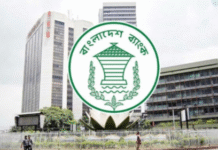Shipments of non-apparel items rose 7.49 percent year-on-year to $1.51 billion in the first quarter of the fiscal year as the country is diversifying its export basket to cut reliance on garments.
Tea, frozen fish, jute and jute goods, leather and leather goods, furniture, ceramics, shrimps, vegetables, bicycles and terry towel performed better in the export markets during the quarter from a year earlier.
The garment sector accounts for more than 80 percent of national exports and its dominance continued in the first quarter as well, with apparel shipment fetching $7.14 billion with 7.17 percent year-on-year growth.
However, with the diversification of export baskets, some sectors have been performing well.
After garment, leather and leather goods came in the second spot for the last three years, earning more than $1 billion every year.
“I hope the leather sector will be able to achieve the target this year too as the shipment of those goods are increasing,” said Saiful Islam, president of the Leathergoods and Footwear Manufacturers and Exporters Association of Bangladesh.
The target for leather and leather goods for fiscal 2017-18 has been fixed at $1.38 billion.
In the July-September period, leather and leather goods fetched $324.62 million, up 1.74 percent from a year earlier, according to data from the Export Promotion Bureau.
The export of leather and leather goods declined to some extent because of relocation of tanneries from Hazaribagh to the Savar leather estate. But now, it has rebounded, after about 25 tanneries started production in the new estate at Savar, according to Islam.
The shipment of leathers goods to new destinations such as Japan and Singapore, apart from the traditional markets of the EU, Canada and the US, is increasing at a faster rate, he said.
The entrepreneur said leather and leather goods manufacturers are more compliant, earning the retailers’ confidence. “As a result, they are coming to Bangladesh and placing an increasing number of orders.”
The contribution of the non-apparel sector in the national export earning has been targeted to increase to 25 percent, according to the Seventh Five-Year Plan.
Similarly, exports of frozen fish went up 23.08 percent year-on-year to $168.27 million in the first quarter thanks to favourable pricing, according to industry insiders.
“The export volume of fish, especially shrimp, did not increase this season, but the prices rose as the demand for our local variety of black tiger shrimp has increased in the Western world,” said Kazi Belayet Hossain, senior vice-president of Bangladesh Frozen Foods Exporters Association.
Exporters are receiving between $7.5 and $8 for every pound of shrimp, up from $5.5 to $6 a year earlier, according to Hossain.
“Our frozen fish market is just rebounding after some years,” said.
Export of fruits and vegetables are bouncing back after the government last month lifted nearly a year-long self-imposed ban on export of agricultural products to the EU, said Mohammad Mansur, general secretary of the Bangladesh Fruits, Vegetables & Allied Products Exporters’ Association.
During the ban, exporters had shipped fruits like jackfruits and mangoes in bulk as the two items were out of the purview of the initiative.
The government had imposed the ban to avoid any major trade measures from the EU as questions had been raised about the quality of products of some consignments.
The lifting of the ban came after the opening of a newly-constructed central packaging plant in the capital’s Shyampur. “So, our export is growing again,” Mansur added.
Jute and jute goods export increased 15.46 percent year-on-year to $236.12 million.
Industry people said the demand for jute and jute goods items increased in the once war-torn Middle Eastern countries.
Source: The Daily Star









